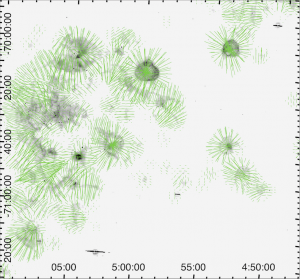Our PhD-student Caroline Collischon published a paper titled “Tracking down the origin of superbubbles and supergiant shells in the Magellanic Clouds with Minkowski tensor analysis”. In collaboration with Prof. Dr. Klaus Mecke of the Institute of Theoretical Physics, an automatic bubble-recognition routine based on Minkowski functionals (MF) and tensors (MT) was developed to detect bubble-like interstellar structures in optical emission line images.
Such interstellar bubbles are created by strong stellar winds of massive stars and their supernova explosions. In the optical images, one can see the emission from the shells consisting of swept-up interstellar gas. In this project, the interstellar medium in the Magellanic Clouds, which are the largest satellite galaxies of our Milky Way, was studied.
Bubbles are detected by tracing back the origins of filaments by drawing lines perpendicular to each filament. For a circular bubble, those lines meet in the center and a large line density is generated. This allows for an automatic bubble detection.

H alpha image with detected bubbles. Lines are drawn perpendicular to filaments and high line density marks the centers of bubbles.
In line-density maps of the Large Magellanic Cloud (LMC), maxima can be found in regions with high star formation in the past, often inside supergiant shells (SGS). In the Small Magellanic Cloud (SMC), bubble detection is impaired by the more complex projected structure of the galaxy. Line maps at large scales show large filaments in the SMC in a north-south direction, especially in the [SII] image. The origin of these filaments is unknown and requires further investigation.
Further information:
For more information contact:
Caroline Collischon
caroline.collischon@fau.de
+49 9131 85-81016
Manami Sasaki
Manami.Sasaki@fau.de
+49 9131 85-81019





